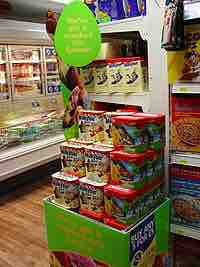Introduction
At some point in your life, you have been motivated and stimulated to buy something on impulse: an unplanned and somewhat emotionally driven purchase. Don't be ashamed. You aren't alone. According to research, almost 66% of all decisions to buy something are made while people are in the store shopping. What's more, 53% of these decisions are classified as impulse buying.
Point of purchase promotions offer marketers one of the most effective sales promotion tools included in the "promotional mix."
Point-of-Purchase Promotion Defined
Point-of-sale displays (POS) are a specialized form of sales promotion found near, on, or next to a checkout counter (the "point of sale"). They are intended to draw the customers' attention to products. These may be new products, a special offer, or may promote special events, such seasonal or holiday-time sales.

Point-of-Purchase Display
A point-of-sale display selling products related to the Easter holiday.
POS displays can include:
- shelf edging
- dummy packs
- display packs
- display stands
- mobiles
- posters
- banners.
Note that POS can also refer to systems used to record transactions between the customer and the commerce, such as check-out registers, which are used at the point of sale. Don't get confused if you see it used in this context.
How It Works
In smaller retail outlets, POS displays are usually supplied by the manufacturer of the products, but sited, restocked, and maintained by in-store salespersons. This is less common in larger retail outlets with strong purchasing power, because they control supplier activities and prefer to use sales material designed in-house to ensure that store layouts and corporate themes are consistent.
Common items that may appear in year-round POS displays are:
- batteries
- soft drinks
- candy
- chewing gum
- magazines
- comics
- tobacco
- writable CDs and DVDs.
POS displays are also useful in outlets with limited floor space, as a way to utilize the much wasted space around counters.
The disposable displays are usually covered with product branding. They are usually made out of cardboard, foam board, or Perspex/Plexiglas stands covered with plastic,and are easily replaceable. Displays are visually appealing because designers are able to make full use of color and special printing processes.
Non-disposable displays may include lighting for more visibility or include a cooler for drinks or ice cream. Some are as simple as a metal baskets that are easy to refill or re-stock, with a price sign and no design on the outside.
Light Boxes
A light box is the advertising industry term for a lighted POS display. These are similar to ones used by photographers, and use fluorescent bulbs to illuminate a poster that has been inserted into the light box from either the side or the rear.
Creating Point-of-Purchase Displays that Work
Setting up a display at a cash register, though simple in theory, requires planning and knowledge in order to deliver desired results. Poor results may be caused by:
- Failure to adhere to retailer's size/space limitations. Proper fit, within the allotted space, increases chances for success.
- Failure to understand the store's clientele and their true needs -- Your product may have a multitude of benefits, but if the customers don't need those particular benefits they won't buy your product.
- Placing the display in the wrong location -- Different areas in a store prompt different shopper responses. Not even a great display will stimulate a sale if the product is not in sync with the mind of consumer as the display is approached.
- Over design-- Displays should be creative but simple, without encouraging consumer questions or objections.
- Not considering where consumers look when they shop -- Displays should be designed with a shopper's line of sight in mind. They won't buy what they can't see.